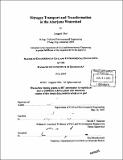Nitrogen transport and transformation in the Aberjona watershed
Author(s)
Choi, Jongsok, 1977-
DownloadFull printable version (5.211Mb)
Other Contributors
Massachusetts Institute of Technology. Dept. of Civil and Environmental Engineering.
Advisor
Harold F. Hemond.
Terms of use
Metadata
Show full item recordAbstract
The Aberjona watershed has been subject to contamination by dense urbanization and industrial effluent. A large amount of nitrogen loading to watersheds nation-widely comes from agricultural areas, but the Aberjona watershed has a considerable nitrogen inflow from .an industrial area. The nitrogen compounds in the Aberjona watershed might be delivered to the estuary near Boston, and could cause damage to the ocean environment. With these concerns in mind, the Aberjona watershed research team measured three kinds of nitrogen compounds and evaluated nitrogen characteristics in different regions. Enormous amount of ammonium has leached to the Aberjona River, one of the tributaries, as the river passes by an industrial area and two superfund sites. Horn Pond Creek, another tributary, has a low level of ammonium and nitrate flux, and dilutes the high concentration of ammonium from the Aberjona River before the creek arrives at the USGS site. In the Aberjona River, nitrification, which is an oxidization reaction from NH4+ to NO3 -, would be expected due to a high concentration of ammonium. In the Horn Pond Creek, denitrification, which is reduction reaction from NO3- to N2 , seems to take place between Horn Pond and Wedge Pond. As for organic nitrogen, it comprises around 15 %-30% of total nitrogen through the watershed.
Description
Thesis (M.Eng.)--Massachusetts Institute of Technology, Dept. of Civil and Environmental Engineering, 2003. Includes bibliographical references (leaves [50]-[53]).
Date issued
2003Department
Massachusetts Institute of Technology. Department of Civil and Environmental EngineeringPublisher
Massachusetts Institute of Technology
Keywords
Civil and Environmental Engineering.